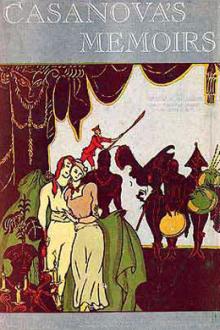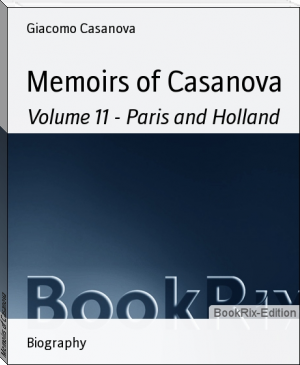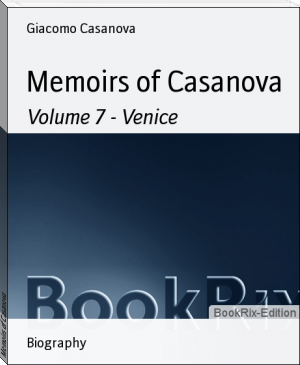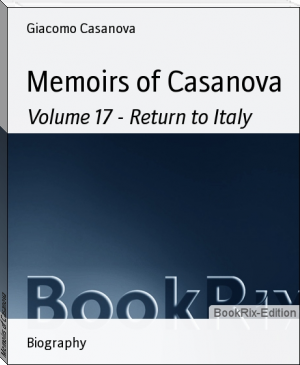The Complete Memoirs of Jacques Casanova de Seingalt by Giacomo Casanova (list of e readers .txt) 📕

- Author: Giacomo Casanova
- Performer: -
Book online «The Complete Memoirs of Jacques Casanova de Seingalt by Giacomo Casanova (list of e readers .txt) 📕». Author Giacomo Casanova
This manuscript, in its original state, has never been printed. Herr Brockhaus, on obtaining possession of the manuscript, had it translated into German by Wilhelm Schutz, but with many omissions and alterations, and published this translation, volume by volume, from 1822 to 1828, under the title, 'Aus den Memoiren des Venetianers Jacob Casanova de Seingalt.' While the German edition was in course of publication, Herr Brockhaus employed a certain Jean Laforgue, a professor of the French language at Dresden, to revise the original manuscript, correcting Casanova's vigorous, but at times incorrect, and often somewhat Italian, French according to his own notions of elegant writing, suppressing passages which seemed too free-spoken from the point of view of morals and of politics, and altering the names of some of the persons referred to, or replacing those names by initials. This revised text was published in twelve volumes, the first two in 1826, the third and fourth in 1828, the fifth to the eighth in 1832, and the ninth to the twelfth in 1837; the first four bearing the imprint of Brockhaus at Leipzig and Ponthieu et Cie at Paris; the next four the imprint of Heideloff et Campe at Paris; and the last four nothing but 'A Bruxelles.' The volumes are all uniform, and were all really printed for the firm of Brockhaus. This, however far from representing the real text, is the only authoritative edition, and my references throughout this article will always be to this edition.
In turning over the manuscript at Leipzig, I read some of the suppressed passages, and regretted their suppression; but Herr Brockhaus, the present head of the firm, assured me that they are not really very considerable in number. The damage, however, to the vivacity of the whole narrative, by the persistent alterations of M. Laforgue, is incalculable. I compared many passages, and found scarcely three consecutive sentences untouched. Herr Brockhaus (whose courtesy I cannot sufficiently acknowledge) was kind enough to have a passage copied out for me, which I afterwards read over, and checked word by word. In this passage Casanova says, for instance: 'Elle venoit presque tous les jours lui faire une belle visite.' This is altered into: 'Cependant chaque jour Therese venait lui faire une visite.' Casanova says that some one 'avoit, comme de raison, forme le projet d'allier Dieu avec le diable.' This is made to read: 'Qui, comme de raison, avait saintement forme le projet d'allier les interets du ciel aux oeuvres de ce monde.' Casanova tells us that Therese would not commit a mortal sin 'pour devenir reine du monde;' pour une couronne,' corrects the indefatigable Laforgue. 'Il ne savoit que lui dire' becomes 'Dans cet etat de perplexite;' and so forth. It must, therefore, be realized that the Memoirs, as we have them, are only a kind of pale tracing of the vivid colours of the original.
When Casanova's Memoirs were first published, doubts were expressed as to their authenticity, first by Ugo Foscolo (in the Westminster Review, 1827), then by Querard, supposed to be an authority in regard to anonymous and pseudonymous writings, finally by Paul Lacroix, 'le bibliophile Jacob', who suggested, or rather expressed his 'certainty,' that the real author of the Memoirs was Stendhal, whose 'mind, character, ideas and style' he seemed to recognise on every page. This theory, as foolish and as unsupported as the Baconian theory of Shakespeare, has been carelessly accepted, or at all events accepted as possible, by many good scholars who have never taken the trouble to look into the matter for themselves. It was finally disproved by a series of articles of Armand Baschet, entitled 'Preuves curieuses de l'authenticite des Memoires de Jacques Casanova de Seingalt,' in 'Le Livre,' January, February, April and May, 1881; and these proofs were further corroborated by two articles of Alessandro d'Ancona, entitled 'Un Avventuriere del Secolo XVIII., in the 'Nuovo Antologia,' February 1 and August 1, 1882. Baschet had never himself seen the manuscript of the Memoirs, but he had learnt all the facts about it from Messrs. Brockhaus, and he had himself examined the numerous papers relating to Casanova in the Venetian archives. A similar examination was made at the Frari at about the same time by the Abbe Fulin; and I myself, in 1894, not knowing at the time that the discovery had been already made, made it over again for myself. There the arrest of Casanova, his imprisonment in the Piombi, the exact date of his escape, the name of the monk who accompanied him, are all authenticated by documents contained in the 'riferte' of the Inquisition of State; there are the bills for the repairs of the roof and walls of the cell from which he escaped; there are the reports of the spies on whose information he was arrested, for his too dangerous free-spokenness in matters of religion and morality. The same archives contain forty-eight letters of Casanova to the Inquisitors of State, dating from 1763 to 1782, among the Riferte dei Confidenti, or reports of secret agents; the earliest asking permission to return to Venice, the rest giving information in regard to the immoralities of the city, after his return there; all in the same handwriting as the Memoirs. Further proof could scarcely be needed, but Baschet has done more than prove the authenticity, he has proved the extraordinary veracity, of the Memoirs. F. W. Barthold, in 'Die Geschichtlichen Personlichkeiten in J. Casanova's Memoiren,' 2 vols., 1846, had already examined about a hundred of Casanova's allusions to well known people, showing the perfect exactitude of all but six or seven, and out of these six or seven inexactitudes ascribing only a single one to the author's intention. Baschet and d'Ancona both carry on what Barthold had begun; other investigators, in France, Italy and Germany, have followed them; and two things are now certain, first, that Casanova himself wrote the Memoirs published under his name, though not textually in the precise form in which we have them; and, second, that as their veracity becomes more and more evident as they are confronted with more and more independent witnesses, it is only fair to suppose that they are equally truthful where the facts are such as could only have been known to Casanova himself.
II
For more than two-thirds of a century it has been known that Casanova spent the last fourteen years of his life at Dux, that he wrote his Memoirs there, and that he died there. During all this time people have been discussing the authenticity and the truthfulness of the Memoirs, they have been searching for information about Casanova in various directions, and yet hardly any one has ever taken the trouble, or obtained the permission, to make a careful examination in precisely the one place where information was most likely to be found. The very existence of the manuscripts at Dux was known only to a few, and to most of these only on hearsay; and thus the singular good fortune was reserved for me, on my visit to Count Waldstein in September 1899, to be the first to discover the most interesting things contained in these manuscripts. M. Octave Uzanne, though he had not himself visited Dux, had indeed procured copies of some of the manuscripts, a few of which were published by him in Le Livre, in 1887 and 1889. But with the death of Le Livre in 1889 the 'Casanova inedit' came to an end, and has never, so far as I know, been continued elsewhere. Beyond the publication of these fragments, nothing has been done with the manuscripts at Dux, nor has an account of them ever been given by any one who has been allowed to examine them.
For five years, ever since I had discovered the documents in the Venetian archives, I had wanted to go to Dux; and in 1899, when I was staying with Count Lutzow at Zampach, in Bohemia, I found the way kindly opened for me. Count Waldstein, the present head of the family, with extreme courtesy, put all his manuscripts at my disposal, and invited me to stay with him. Unluckily, he was called away on the morning of the day that I reached Dux. He had left everything ready for me, and I was shown over the castle by a friend of his, Dr. Kittel, whose courtesy I should like also to acknowledge. After a hurried visit to the castle we started on the long drive to Oberleutensdorf, a smaller Schloss near Komotau, where the Waldstein family was then staying. The air was sharp and bracing; the two Russian horses flew like the wind; I was whirled along in an unfamiliar darkness, through a strange country, black with coal mines, through dark pine woods, where a wild peasantry dwelt in little mining towns. Here and there, a few men and women passed us on the road, in their Sunday finery; then a long space of silence, and we were in the open country, galloping between broad fields; and always in a haze of lovely hills, which I saw more distinctly as we drove back next morning.
The return to Dux was like a triumphal entry, as we dashed through the market-place filled with people come for the Monday market, pots and pans and vegetables strewn in heaps all over the ground, on the rough paving stones, up to the great gateway of the castle, leaving but just room for us to drive through their midst. I had the sensation of an enormous building: all Bohemian castles are big, but this one was like a royal palace. Set there in the midst of the town, after the Bohemian fashion, it opens at the back upon great gardens, as if it were in the midst of the country. I walked through room after room, along corridor after corridor; everywhere there were pictures, everywhere portraits of Wallenstein, and battle-scenes in which he led on his troops. The library, which was formed, or at least arranged, by Casanova, and which remains as he left it, contains some 25,000 volumes, some of them of considerable value; one of the most famous books in Bohemian literature, Skala's History of the Church, exists in manuscript at Dux, and it is from this manuscript that the two published volumes of it were printed. The library forms part of the Museum, which occupies a ground-floor wing of the castle. The first room is an armoury, in which all kinds of arms are arranged, in a decorative way, covering the ceiling and the walls with strange patterns. The second room contains pottery, collected by Casanova's Waldstein on his Eastern travels. The third room is full of curious mechanical toys, and cabinets, and carvings in ivory. Finally, we come to the library, contained in the two innermost rooms. The book-shelves are painted white, and reach to the low-vaulted ceilings, which are whitewashed. At the end of a bookcase, in the corner of one of the windows, hangs a fine engraved portrait of Casanova.
After I had been all over the castle, so long Casanova's home, I was taken to Count Waldstein's study, and left there





Comments (0)